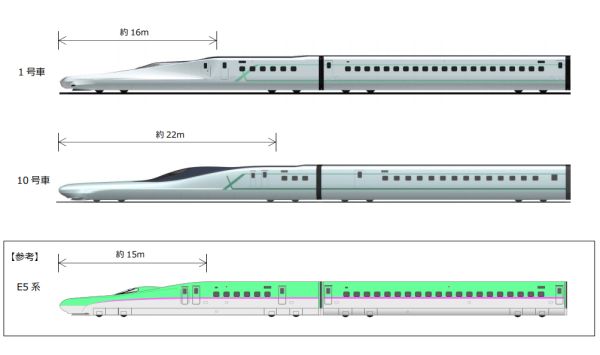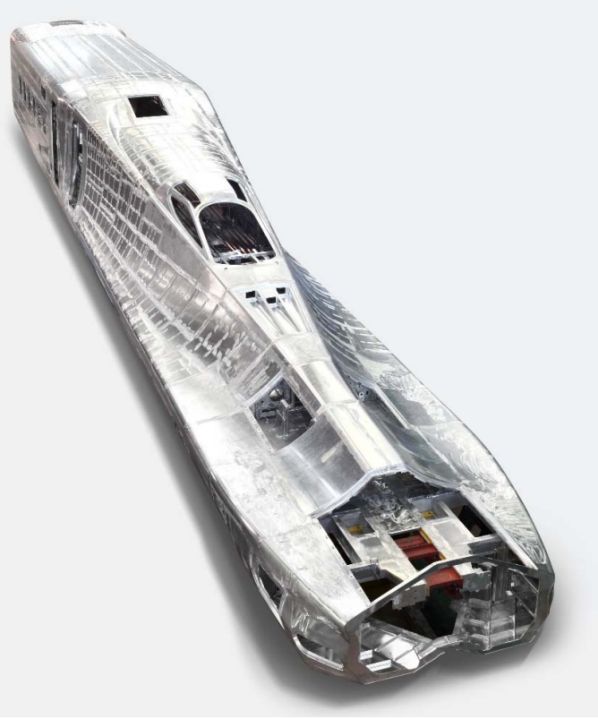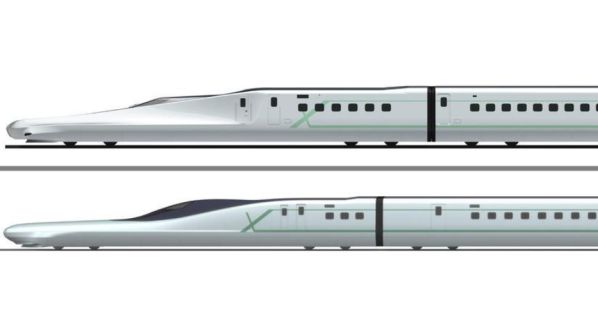EAST Japan Railway (JR East) announced its mid-to-long-term vision for technological innovation in November 2016 which included research and development for a next-generation Shinkansen train. The objective is to attain a high level of safety, stability, and comfort, while reducing the environmental impact of the train and making it easier to maintain than the current generation of Shinkansen rolling stock.
JR East therefore decided to build a new high-speed test train - Alfa-X or series E956 - for the Shinkansen as an experimental platform to embody the concept. This train is being developed with the extension of the Hokkaido Shinkansen from Shin-Hakodate-Hokuto to Sapporo in mind while taking into account the technical advances achieved in existing trains.
The idea of building a test train when we contemplate increasing the speed of the Shinkansen is not new. Our development of Shinkansen trains started with tests for running the 400 series at speeds up to 345.8km/h in 1991. This was followed by the Star21 and FastTech360 test trains which reached even higher speeds. This work has enabled us to shorten journey times, advance technology, increase safety, reduce noise levels, and improve ride comfort.
The concept for Star21 was to develop an extremely lightweight high-speed train using many new technologies. During dynamic tests, which were conducted between 1992 and 1998, the train reached a maximum speed of 425km/h. Star21 helped to achieve a significant step forward in environmental technology, and the resulting weight reduction and main circuit technologies are used in trains currently in service. In addition, we were able to reveal high-speed rail issues not only related to vehicles but also in other areas such as track, power supply, signalling, and earthworks.
With FastTech360, rather than trying to break previous test speed records, we set out to raise operating performance, and attain the maximum possible reliability, comfort and environmental friendliness. Test running was conducted between 2005 and 2009 and led to the development of the E5 and E6 series trains running at 320km/h, the highest operating speed in Japan.
JR East is developing its next-generation train with the opening of the 211km extension of the Hokkaido Shinkansen from Shin-Hakodate-Hokuto to Sapporo in 2030 in mind. We believe it is essential to give customers not only a safe and fast means of transport but also new facilities for them to enjoy during the five-hour trip from Tokyo to Sapporo. For relatively long rail journeys we use the concept of “extra time.” Rail passengers have far more usable time during the journey compared with air travellers, where the trip is broken into short sections to reach the airport, pass through check-in and security, with often long distances to walk to reach the gate, resulting in a lot of wasted time before, during and after the flight.
To achieve these goals, we intend to use the AI technologies of IoT and big data analysis and combine them with research results to raise safety and reliability levels.
To take safety up a notch, we want to find ways to stop trains more quickly and safely during an earthquake, and to have individual vehicles carry out autonomous checks on the condition of key components. We also want to improve stability through greater resistance to snow and cold and enhance failure prevention by detecting faults from vehicle and ground monitoring data.
Passenger needs vary, so we must be flexible in meeting them. Customers want to spend their time in comfort, be able to concentrate on their work, or to enjoy the journey with their families. We also want to achieve a quieter and smoother ride and ensure punctuality.
To minimise rail’s environmental impact, our noise reduction technologies have been developed to suppress noise when trains run at high speed. We also promote energy conservation through various technologies.
To reform our maintenance practices, we are promoting condition-based maintenance for both the trains and infrastructure.
Test train
The new high-speed Shinkansen test train Alfa-X, which stands for Advanced Labs for Frontline Activity in rail eXperimentation, will help us to achieve these improvements and innovations well into the future.
The E956 10-car test train will be completed in spring 2019 and will operate at a maximum speed of about 400km/h during testing.
Two types of device will be developed to protect against the risk of derailment during earthquakes. One is a damper moving laterally and the other is a crushable stopper. The damper works like a conventional damper moving to the right and left, but when an earthquake occurs and severely shakes the train laterally, it exerts a strong damping force to suppress shaking. When the test train experiences a seismic shock, the stopper will be pressed. As a result, the space between the centre pin and stopper spreads to mitigate the shock between the car body and bogie and to prevent high lateral pressure from occurring between the wheel and rail.
In order to stop a train quickly when an earthquake occurs, existing trains only have a mechanical braking system consisting of a brake disk, calliper, and lining which relies on the adhesion force between the wheel and rail.
To develop a high-deceleration brake, we are working on a non-adhesion deceleration system that compensates for lack of braking force at high speed to shorten the stopping distance. One candidate is an air-resistant-plate unit that splits the air resistance enhancer installed in FastTech360 into small units. This will give Alfa-X an advantage over FastTech360, as the small units will be distributed throughout the train and will take up less space inside.

To improve reliability, we plan to install equipment which has greater resistance to snow and cold and which is designed to reduce the risk of damage or failure in freezing conditions. The underfloor layout will be optimised to minimise the build-up of ice and snow.
We also plan to monitor various devices to detect failures and to prevent problems from occurring.
Fully-active controller
The E2 series Shinkansen was the first train to enter service fitted with a pneumatic actuator working as a fully active controller that reduced lateral shaking. For the E5 series Shinkansen, JR East changed to a motor-driven actuator to improve responsiveness and power control. We plan to introduce a fully-active controller with higher performance and a body tilt controller on the latest test train, together with a new controller against the vertical to produce a “shake-free” train. We will also develop technology to operate the train stably at 360km/h.
The bodyshell of Alfa-X will be designed for high sound absorption and will have better insulation to improve passenger comfort.
JR East is already undertaking a variety of condition-based maintenance initiatives for both the conventional network and Shinkansen. We will develop this further by using the test train as an experimental platform, and we will add devices that monitor on-board and ground equipment to acquire and analyse data for maintenance reform.
To reduce pressure waves when a train enters a tunnel, we will verify two new shapes for the driving car of the test train. Type A’s 16m-long nose is 1m longer than that of the E5 series Shinkansen, whereas Type B has a 22m-long nose. We also plan to maintain the in-vehicle space in the train.
Various anti-noise measures are planned such as reducing the noise generated from the lower part of the body and cutting brake disk aerodynamic noise by reviewing the fin shape on the back of the disk. We are conducting simulation and wind tunnel tests to develop a new pantograph that will produce less aerodynamic noise.

To save energy, we will reduce the power conversion losses by improving the efficiency of the traction equipment. For example, energy consumption efficiency can be improved through optimal drive control technology and by using silicon carbide (SiC) semiconductors for the power converter. By using IoT, big data, and AI, we are working on how to enhance the on-board information and control network of the test train and to make it more robust than that of the E5 series.
In addition, the trains will be equipped with a device which increases aerodynamic drag to aid rapid deceleration.
For the next-generation Shinkansen, we want to build an intelligent train with a high level of safety, stability, comfort, environmental performance, and maintainability. But, in order to achieve this, we need cooperation from outside organisations, such as manufacturers and research institutes, to move forward with this project, all working as one to go beyond the technical barriers.

